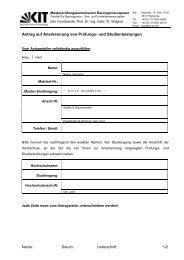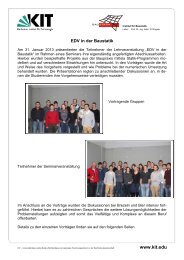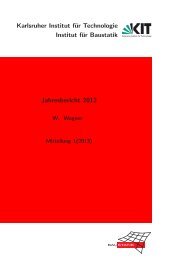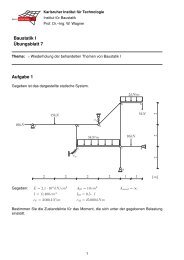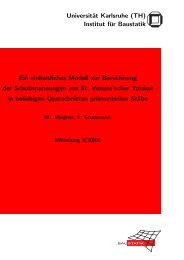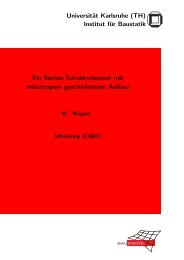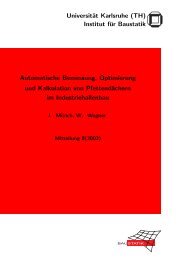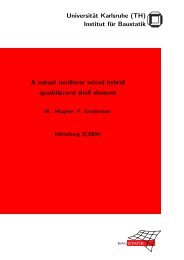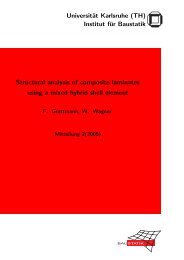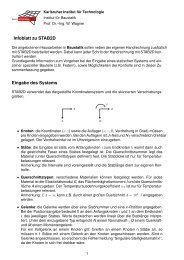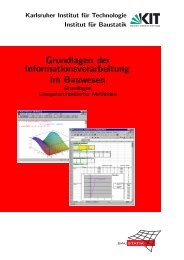Karlsruher Institut für Technologie Institut für Baustatik Adhesive ...
Karlsruher Institut für Technologie Institut für Baustatik Adhesive ...
Karlsruher Institut für Technologie Institut für Baustatik Adhesive ...
- No tags were found...
Create successful ePaper yourself
Turn your PDF publications into a flip-book with our unique Google optimized e-Paper software.
(a) (b) (c)Figure 9: Photographs of MMB fracture surfaces; specimen 6 with β = 0.25 (a), specimen 7 with β = 0.5 (b), and specimen 3 with β = 0.75 (c)(crack propagation direction from top to bottom).G II = 9[F (c + l 2 ) + F g (c g + l 2 )]2 (a + 0.42χh) 2 , (7)4 b 2 t 3 l 2 E 1 fwhere F is the applied load, F g is the weight of the loading lever and the attached apparatus, and c g is the distancebetween the center of gravity and the center roller. A correction is thus included to take into account loading causedby the lever weight. Clearly, c g changes with the lever load position. Note that equations (3)–(7) are taken from thestandard. The tests were performed displacement-controlled with a quasi-static displacement rate of 0.5 mm/min,where the controlled displacement is the cross-head displacement in the load line of the lever arm, Δ MMB , as seen inFig. 8.Table 2: Geometrical data of the MMB test specimens (in mm).β c l adh a 0 w t0.25 76.4 70.7 29.3 25.0 1.700.50 41.1 70.1 29.9 24.8 1.700.75 29.6 70.1 29.9 24.9 1.75Figs. 7 (b)–(d) show the experimental load-displacement curves. We see that the initial response is linear elastic.At some point –characterized by the subscript ’nlin’ in the following– the response starts to deviate from linearityand becomes non-linear. At a later stage –denoted by the subscript ’max’ in the following– the maximum load isreached followed by stable crack propagation. Unloading is almost linear to the origin, hence plasticity effects withinthe adhesive can be neglected. This qualitative response can be observed for all of the three mode mixing ratios.The failure locus in all tests for all mode mixtures was somewhere in the adhesive layer, though the crack jumpedto the adhesive/composite interface in some cases, and also into the composite plates in small stripes along the longitudinalside edges, as seen in Fig. 9. The latter effect is likely due to local damage caused by the cutting process andoccurred only when the crack tip was far away from the initial crack tip, hence it has no influence on the initiationCERR values. The experimental outcome is useful for damage tolerance analyes since in real structures with realisticloading scenarios it can be expected that the failure locus is similar. However, the CERR has to be interpreted to beeffective, since it lumps together different failure loci, and thus different failure mechanisms.According to the standard [18] one has two options for the extraction of an initiation CERR. The first one is based11



